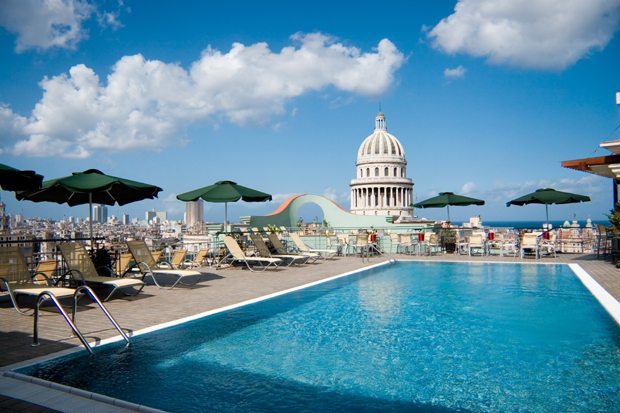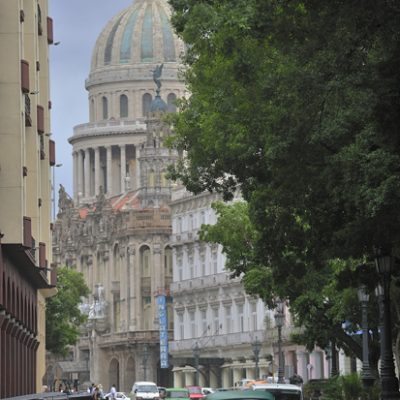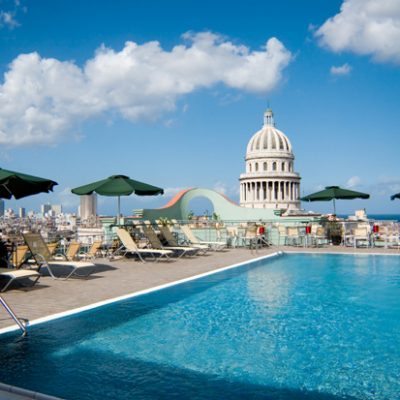
THE DOORS TO GLORIOUS HAVANA ARE OPEN…AT LAST
BY CHRISTOPHER P. BAKER
After 50 years of economic and social exile, America’s doors to the island nation of Cuba are slowly opening. In January, the Obama Administration’s Department of State announced that there are now a dozen legal reasons to visit the country, including family visits, humanitarian missions, cultural and sports performances, journalism, research, and religious activities, or simply to present and/or attend educational or academic programs. The categories are so broad that one would hard pressed to not find a reason to hop on Jet Blue (currently, the only major U.S. carrier flying direct from John F. Kennedy International Airport) and visit one of the most remarkable cultural destinations on the planet. —Matt Scanlon
Havana has a flavor all its own, a merging of colonialism, capitalism, and Communism. One of the great historical cities of the New World, it’s also a far cry from typical Caribbean capitals. Its buildings come in a spectacular amalgamation of styles—from the academic classicism of aristocratic homes, Rococo residential exteriors, Moorish interiors, and Art Deco and Art Nouveau to stunning examples of modernity.
At the heart of this city of 2.2 million is enchanting Habana Vieja (Old Havana), a living museum inhabited by 60,000 people and containing perhaps the finest collection of Spanish-colonial buildings in the Americas. Baroque churches, convents, and castles that could have been transposed from Madrid or Cádiz still reign majestically over squares ornamented by the former palaces of Cuba’s once ruling class.
This political, cultural, and industrial heart of the nation lies 93 miles due south of Florida, on Cuba’s northwest coast. It is built on the west side of a sweeping bay (Bahía de la Habana) and extends eight miles west to the Río Jaimanitas, then south for an equal distance.
Metropolitan Havana sprawls over 286 square miles, and incorporates 15 municipios (municipalities). It’s also a collection of neighborhoods, each with its own character. Since the city is so spread out, it is best to explore in sections, concentrating time on the three main districts of touristic interest: Habana Vieja, Vedado, and Miramar, in that order.
If you have only one or two days, book a get-your-bearings trip by HabanaBusTour or hop on an organized city tour offered by Havanatur Tour and Travel or a similar agency. This will provide an overview of the major sites. Concentrate the balance of time around Parque Central, Plaza de la Catedral, and Plaza de Armas. Your checklist of must-sees should include the Capitolio Nacional, Museo de la Revolución, Museo Nacional de Bellas Artes, Catedral de la Habana, Museo de la Ciudad de la Habana, and Parque Histórico Militar Morro-Cabaña, the last featuring two restored castles attended by soldiers in period costume.
Habana Vieja, the original colonial city within 17th-century walls (now demolished), will require at least three days to fully explore, so base yourself in one of the charming historic hotel conversions close to the main sights of interest.
Centro Habana has many notable architectural home designs, but few other sites of interest, and its rubble-strewn, dimly-lit streets aren’t the safest. Skip Centro for Vedado, the modern heart of the city that evolved in the early 20th century, with many ornate mansions in Beaux-Arts and Art Nouveau style—its leafy streets make for great walking. Many of the city’s best homes are here, as are most businesses, paladares (family- run restaurants), and nightclubs. The Hotel Nacional, Universidad de la Habana, Cementerio Colón, and Plaza de la Revolución are sights not to miss.
If you’re interested in Beaux-Arts or Art Deco architecture, then the once glamorous Miramar, Cubanacán, and Siboney regions west of Vedado are worth exploring. Miramar also has excellent restaurants, deluxe hotels, and some of our favorite nightspots.
Most other sections of Havana are run-down residential districts of little interest to tourists. A few exceptions lie on the east side of the harbor. Regla and neighboring Guanabacoa are together a center of Santería and Afro-Cuban music, while the 18th-century fishing village of Cojímar has its Hemingway association (the nearby community of San Miguel de Padrón is where the great author lived for 20 years). A visit to his home, Finca Vigía (today the Museo Ernest Hemingway), is de rigueur. (Combine it with a visit to the exquisite colonial Iglesia de Santa María del Rosario.) About 10 miles east of the city, the long, white-sand beaches of the Playas del Este prove tempting on hot summer days. (The high season for tourism is from mid-November to mid-March, in which temperatures are coolest and the chance of downpours lowest.)
In the suburban district of Boyeros, the Santuario de San Lázaro is an important pilgrimage site. A visit here can be combined with the nearby Mausoleo Antonio Maceo, where the hero general of the Cuban War of Independence (1895–1898) is buried outside the village of Santiago de las Vegas. A short distance east, the Arroyo Naranjo district has Parque Lenin, a vast park with an amusement park, horseback rides, boating, and more. Enthusiasts of botany can also visit the botanical garden, Jardín Botánico Nacional, in which in no fewer than 4,000 plant species are on display.
Despite Havana’s great size, most sights of interest are highly concentrated, and most exploring is best done on foot.
Which District?
Location is important in choosing your hotel. Habana Vieja puts you in the heart of the old city and within walking distance of main tourist sights. Two dozen colonial era mansions administered by Habaguanex (habaguanex.ohc.cu) offer yesteryear ambience and modern bathrooms, plus there’s a full range of state-run hotels and a wide choice of private room rentals.
Centro Habana, although offering few sites of interest, has budget-oriented hotels, but safety can be a concern. Vedado and Plaza de la Revolución offer mid-20thcentury accommodations well situated for sightseeing, including several first-class modern-design hotels with interesting décor. Vedado also has dozens of examples of superb home architecture. Playa Miramar and beyond has moderate hotels popular with tour groups, as well as deluxe hotels aimed at business travelers. All are far from the main tourist sights and you’ll need wheels or taxis to get around.
Adapted from the Moon travel guide Havana, by Christopher P. Baker. May 2015, 256 pages, $16.99. Copyright © Moon Travel Guides. moon.com
Details, Details
by Industry staff
Get the latest U.S. government information before you go (forms, restrictions, etc.) from travel.state.gov/travel.
Flights on Jet Blue are currently arranged exclusively by the charter business Cuba Travel Services (cubatravelservices.com), though United Airlines is currently seeking permission to operate from Newark Airport.
The CUC, or Cuban Convertible Peso, currently exchanges at 1 per U.S. dollar, plus a 10% exchange tax assessed by the Cuban government. A second legal currency is the Cuban Peso (CUP), and its good to have some handy if trekking outside of touristy areas. Credit cards tied to a U.S. bank are typically not accepted, but banks and large resorts/hotels will let you draw cash on a debit card. The takeaway is: use cash, but withdraw it in small amounts daily.
Tap water is generally not considered safe to drink, so buy bottles, even in luxury hotels.
What is safe, and wonderfully plentiful, is booze. Rum in Havana is ridiculously cheap, even at tourist hot spots. A standard bottle of Havana Club rum can be had for as little as $5 (check alcohol content on bottles, though—they can vary). Cocktails at swanky joints aside, expect to part with about $3 to $4 for Mojitos and Cuba Libres at most places.
Internet access can be spotty, so ask if your hotel is equipped.
According to the U.S. Department of State, although official crime statistics are not published by Cuba, evidence suggests that, as with virtually any city, petty theft and other minor crimes can be a problem in Havana. Most crime can be characterized as non-confrontational (i.e. pick-pocketing, purse-snatching, and thefts from cars and dwellings). Locals can often be silent and/or suspicious (a consequence of a half-century of negative indoctrination), so be wary any of any overly solicitous characters.
As with travel anywhere, make certain your health insurance provider will honor your policy should you need medical treatment in Cuba, and confirm it in writing. Any medical treatment must be paid for before being allowed to leave the country.







